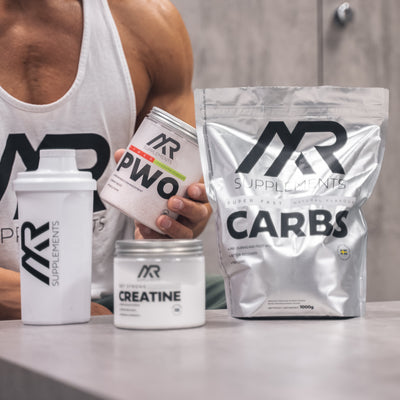Progressive overload is a central principle in strength training and is crucial to achieving increased muscle mass and strength over time. Here is important information about strength training and its relationship to progressive overload:
Strength Training and Progressive Overload:
-
Definition:
- Progressive overload involves gradually increasing the load or effort placed on the muscles during exercise. This is required to stimulate muscle adaptation and growth.
- Progressive overload involves gradually increasing the load or effort placed on the muscles during exercise. This is required to stimulate muscle adaptation and growth.
-
Mechanism of Muscle Adaptation:
- When you put your muscles under more strain than they are used to, it causes microscopic damage to the muscle fibers. During recovery from exercise, these fibers repair and grow, leading to increased muscle mass and strength.
- When you put your muscles under more strain than they are used to, it causes microscopic damage to the muscle fibers. During recovery from exercise, these fibers repair and grow, leading to increased muscle mass and strength.
-
Why Progressive Overload is Important:
- The body adapts to the stresses it is put under. If you don't increase the load, the muscles won't have the incentive to grow. Progressive overload ensures a constant challenge and promotes continued progress.
- The body adapts to the stresses it is put under. If you don't increase the load, the muscles won't have the incentive to grow. Progressive overload ensures a constant challenge and promotes continued progress.
-
Ways to Achieve Progressive Overload:
- Increased Weight: Gradually increase the amount of weight you lift during your workout.
- More Repetitions: Increase the number of repetitions with the same weight.
- More Sets: Add more sets of each exercise.
- Increased Training Frequency: Train more frequently to increase the total volume of training.
-
Change Exercise Variations: Introduce new exercises or variations to challenge the muscles in different ways.
-
Training Program and Planning:
- A well-structured training program should incorporate various training principles and apply progressive overload over time. It may include different phases such as a building phase, a strengthening phase, and periods of recovery.
- A well-structured training program should incorporate various training principles and apply progressive overload over time. It may include different phases such as a building phase, a strengthening phase, and periods of recovery.
-
The Importance of Variation:
- To avoid performance plateaus, it's also important to vary your training regularly. This can include changes in exercises, reps, sets, or weights.
- To avoid performance plateaus, it's also important to vary your training regularly. This can include changes in exercises, reps, sets, or weights.
-
Rest and Recovery:
- Progressive overload should be balanced with adequate rest and recovery. Muscles need time to repair and grow between workouts.
- Progressive overload should be balanced with adequate rest and recovery. Muscles need time to repair and grow between workouts.
-
Continuous Adaptation:
- Training should be adapted over time based on individual progress and goals. It is important to pay attention to your body's signals and adjust your training as needed.
- Training should be adapted over time based on individual progress and goals. It is important to pay attention to your body's signals and adjust your training as needed.
Understanding and implementing the principle of progressive overload is key to long-term success in strength training and muscle building. It's also important to combine this with a healthy diet and adequate sleep to support muscle repair and growth.
Take your training to the next level with Get Strong Creatine
Why should you choose creatine? Let us guide you through the overwhelming benefits and exciting possibilities this powerhouse offers.
Why Our Creatine?
1. Unparalleled Quality: Get Strong Creatine is of the highest quality, carefully crafted to give you pure and concentrated power. We don't compromise on results, and our product is your assurance of superior performance.
2. Fast Absorption: With our advanced formula, we ensure fast absorption to maximize the benefits of creatine. Experience instant energy and power from the first use.
3. Scientifically Backed: Backed by extensive research and scientific studies, our creatine product is designed to deliver results that go beyond promises. We let the science speak for itself when it comes to improving strength and muscle building.
Why Creatine?
1. Increased Strength: Improve your performance and take your strength to new levels. Creatine has been shown to increase muscle power, making every workout an opportunity to surpass yourself.
2. Explosive Energy: Experience a powerful boost of energy during your most intense workouts. Creatine is the key to long-lasting endurance and rapid recovery.
3. High-Speed Muscle Growth: Your path to impressive muscle mass is accelerated with our creatine supplement. The anabolic benefits help you build and maintain muscle mass like never before.
What Sports Is It Ideal For?
1. Strength Trainers and Bodybuilders: For those striving for maximum strength and muscle growth, our creatine product is indispensable. Give your muscles the fuel they need.
2. Fast-paced Sports: For athletes in short-distance running, sprinting, football and other fast-paced sports, creatine provides the explosive power needed to dominate on the track or field.
3. Fitness Enthusiasts: Whether you're an enthusiastic weightlifter or just love to work out, our creatine supplement will enhance every aspect of your training and give you results that inspire.
Give yourself the benefit of scientifically proven creatine and let us help you achieve your training goals. Experience strength on a whole new level.
Examples of Progressive Overload
This program is intended for an individual who is familiar with basic strength training exercises and has access to a gym with free weights.
Weeks 1-4: Build-up phase
Training Day 1: Upper Body
- Bench press: 3 sets x 8 repetitions
- Dumbbell Row: 3 sets x 10 repetitions
- Dumbbell press: 3 sets x 10 repetitions
- Lat pulldown: 3 sets x 12 repetitions
- Bicep curls: 3 sets x 12 repetitions
- Tricep dips: 3 sets x 12 repetitions
Training Day 2: Lower Body
- Squats: 4 sets x 8 repetitions
- Deadlift: 4 sets x 10 repetitions
- Dumbbell lunges: 3 sets x 12 repetitions per leg
- Leg press: 3 sets x 12 repetitions
- Leg curls: 3 sets x 12 repetitions
- Calf press: 3 sets x 15 repetitions
Week 5-8: Strength Phase
Training Day 1: Upper Body
- Bench press: 4 sets x 6 repetitions (increase weight)
- Dumbbell Row: 4 sets x 8 repetitions
- Dumbbell press: 4 sets x 8 repetitions
- Lat pulldown: 4 sets x 10 repetitions
- Bicep curls: 4 sets x 10 repetitions
- Tricep dips: 4 sets x 10 repetitions
Training Day 2: Lower Body
- Squats: 5 sets x 6 repetitions (increase weight)
- Deadlift: 5 sets x 8 repetitions
- Dumbbell lunges: 4 sets x 10 repetitions per leg
- Leg press: 4 sets x 10 repetitions
- Leg curls: 4 sets x 10 repetitions
- Calf press: 4 sets x 12 repetitions
Weeks 9-12: Advanced Phase with Increased Volume
Training Day 1: Upper Body
- Bench press: 5 sets x 5 repetitions (increase weight)
- Dumbbell Row: 5 sets x 8 repetitions
- Dumbbell press: 5 sets x 8 repetitions
- Lat pulldown: 5 sets x 10 repetitions
- Bicep curls: 5 sets x 10 repetitions
- Tricep dips: 5 sets x 10 repetitions
Training Day 2: Lower Body
- Squats: 6 sets x 5 repetitions (increase weight)
- Deadlift: 6 sets x 8 repetitions
- Dumbbell lunges: 5 sets x 10 repetitions per leg
- Leg press: 5 sets x 10 repetitions
- Leg curls: 5 sets x 10 repetitions
- Calf press: 5 sets x 12 repetitions
Note:
- Weights should be increased gradually for each exercise, especially during the strength phase.
- Warming up and cooling down are important and should always be included in every workout.
- Diet and recovery are also crucial to optimizing results.
Adapt the training program to your own level and comfort, and monitor your progress regularly. This is just an example, and training programs should always be adapted to individual goals, needs and physical capacity. Also remember to always train with good technique and form. That the movement pattern looks good and that you get good muscle contact. Technique always comes before load.
Drive hard!




